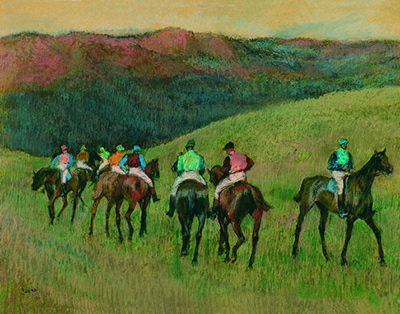This pastel drawing came as late as 1894, at a time when Degas continued to work feverishly around this favoured theme
This particular racehorse painting, now stored at the Thyssen-Bornemisza Museum in Madrid, Spain, uses an expressive style, with the artist formulating his own colour scheme.
The race captured is itself a cross country route, as opposed to many of his previous stadium-based works. This choice enabled him to combine landscape and anatomical portraiture in the same artwork.
This combination is similar to how Thomas Gainsborough would combine portraits and landscapes, such as with Mr and Mrs Andrews. English artists like Bonington had also frequently painted these longer distance cross country races. Delacroix was to do so in France as well.
Paul Gauguin's painting, The Moon and the Earth, was purchased by Degas in 1893 and perhaps was influential in this new approach from Degas. His impressive collection started to expand as his own works achieved higher sums.
Racehorses in a landscape features a group of jockeys preparing to begin this cross country sojourn through a myriad of hills. The attire of these racers continued his desire of depicting the social elite and their pastimes.
It was specifically the dramatic and new chromatic techniques found in Gauguin's Tahitian paintings which set Degas upon this new journey of expression through colour. His selections were to be bold but complementary, a balance others would find hard to achieve.
Degas' work is often categorised by theme rather than chronologically ordering artwork individually. He would not always leave clear documentation around his work. Some titles have only been dated approximately. The simpler route is to discuss his race horse themed paintings and sketches, his ballerinas and other portraiture.
This pastel work was bought by dealer Durand-Ruel and sold on to the Degas collector, Louisine Havemey in the US.
Degas was not someone who was naturally comfortable as a commercial artist but the ends justified the means with regards continuing to expand his own collection of multiple masters.
This pastel drawing raises as many questions as it answers - where might this race me heading? Additionally are there spectators looking on, cropped out of the composition? Typically his racehorse paintings would have people watching on, perhaps this was a new direction?




